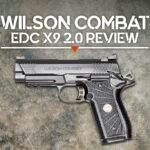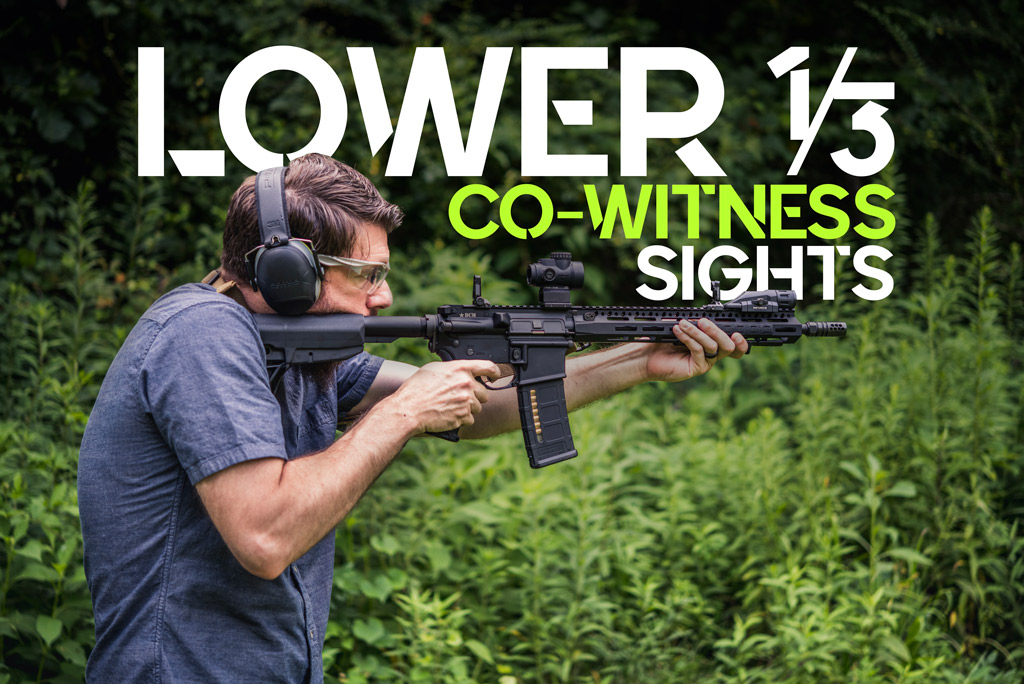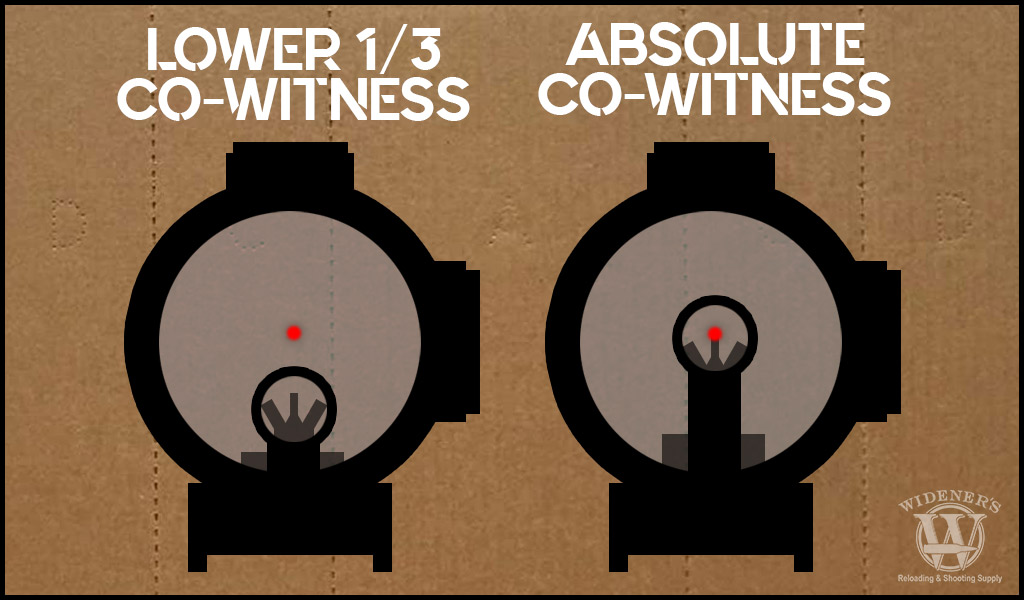

When aiming down the sights of your firearm, are you more comfortable with optics, or iron sights? What if you could engage both? That’s the basic philosophy behind co-witnessed sights. Lower 1/3 co-witness sights take the idea one step further.
Many experienced shooters looking for versatility and flexibility utilize co-witness sights. It combines both iron sights and red dot or other mounted optics. The idea is to maximize accuracy across a variety of ranges and environments.
Let’s take a closer look at what co-witness sights are and explore how lower 1/3 co-witness sights work. By the end, you’ll be able to determine which variety of co-witness sights are a good choice for your firearm set up.
Co-Witness Sights Explained
When you use a firearm, you can utilize two different types of optics. Optical sights are aftermarket or secondary sights that you add to your firearm. These include red dot optics, scopes, and so on. Iron sights are those that come mounted on your weapon.
Normally, both types of optics are used for different situations. Iron sights are typically appropriate for short-range shooting. They do not magnify or increase your visual accuracy beyond providing a basic bracket for where your shot might land.
Optical sights add to accuracy by providing a red aiming dot or magnification effect. Allowing you to hit targets further away or hit moving or close-range targets more readily.
When you “co-witness” sights you use both the optical sights and iron sights of your firearm at the same time. For your sights to be co-witnessed, the optical sight’s red dot has to align with the iron sights either exactly or at a central angle.
Some experienced firearm users prefer co-witnessed sights as it allows them to be prepared for any situation. Whether it’s hitting their target accurately during a hunting expedition or protecting their comrades during a military engagement.
Absolute VS Lower 1/3 Co-Witness Sights

Lower 1/3 co-witness sights have the optic mounted higher than the iron sights. With absolute co-witness, the optic is mounted at the same height as the iron sights.
There are two types of co-witnessed sights: absolute and lower 1/3. While both can be effective, they are typically used for different situations or preferences.
Absolute Co-Witness Sights:
- Matches the dot of a red dot optical sight (or the crosshairs of a scope) with the iron sights perfectly. In theory, the red dot and the iron sights line up such that both report the same projected bullet path.
- They do not require realignments (for instance, from a dark area to a bright area quickly and have to go from using the red dot optic to your iron sights) and so offer a quicker response to changes in your target or environment.
- The optic physically sits closer to the bore.
Absolute co-witness sights are ideal for low cheek sighting and are often favored for urban combat with AK or AR-15 platform setups.
1/3 Or Lower 1/3 Co-Witness Sights:
- The red dot optic or scope sits slightly above and slightly off-center from the iron sights mounted on your firearm. This allows distinct lower 1/3 visibility for the weapon’s iron sights and a less cluttered sight picture for the red dot optic.
- Offer comfortable neck positioning as you don’t have to lean down as low.
- Allow shooters to use the mounted red dot optic (or scope) separately from the iron sights.
With lower 1/3 co-witness sights, a shooter has to drop their head slightly to align the two crosshairs because the optical sight mount will be slightly above the iron sights. As a result, a shooter only sees the iron sights in the bottom third of the optic window (hence the name).
Benefits Of Lower 1/3 Co-Witness Sights

Do you have a neck? If so, you may enjoy the ergonomics of the lower 1/3 co-witness sight picture.
If absolute co-witness sights allow you to use both iron sights and optical sight mounts simultaneously, why would anyone bother with lower 1/3 co-witness sights?
While absolute co-witness sights do have some advantages, lower 1/3 co-witness sights also have their own benefits.
Better Visibility
The primary benefit of the lower 1/3 co-witness sight setup is better visibility. The red dot optic is positioned slightly above and off-center from the iron sights, the iron sights don’t clutter the sight picture from the optic. This allows you to better take advantage of things like hash marks, bullet drop compensating lines, and so on.
The iron sights, too, aren’t cluttered with a red dot or complex reticle. Many experienced shooters find this extra visibility to be more beneficial than having the red dot of their mounted optic match perfectly with their iron sights.
More Neck Comfort
Secondly, lower 1/3 co-witness sights allow you to position your neck more comfortably. Specifically when using a rifle platform like the AR-15 or AK-47. Since your neck will be more comfortable, you’ll be able to focus on your accuracy and reduce the risk of muscle strength/neck muscle kinks.
This is a minor benefit, but it can be important for long hunting sessions or sniper training (if using with a rifle other than an AR-15, of course).
No Issues Using Both Sights
Lower 1/3 co-witness sights do require the red dot or another optic to be slightly off-center from the iron sights. However, it’s not enough to make any problems for experienced shooters. Thus, you can still use both optics in conjunction with one another, such as for shooting a target moving away from you and quickly fleeing from short-range to moderate or long-range distances.
What About Lower 1/3 Disadvantages?
Lower 1/3 co-witness sights sit further from the gun’s bore than absolute co-witness sights. This can make it more difficult to sight in your optic at various distances and maintain accuracy when switching to iron sights.
For example, let’s say you have a target at 25 yards. Your red dot optic is zeroed at 25 yards, but your weapon’s iron sights are zeroed at 10 yards. You’ll need to compensate your aim with your iron sights to be able to hit the target that your red dot is already zeroed for.
Speaking of hitting targets, you’ll also need to adjust to switching between your optic and iron sights with a lower 1/3 co-witness setup. You’ll need to visually raise, or lower your line of sight to engage targets. This may sound difficult, but it actually becomes second nature quickly with time and training at the range.
Which Option Should You Use?

It’s a personal preference, but a lower 1/3 co-witness optic setup offers the best of both worlds.
It all depends on your preferences. Absolute co-witness sights are typically ideal for shooters who want sight picture consistency between their optic and their iron sights. Or for those who prefer running a holographic sight, like an Eotech. However, lower 1/3 co-witness sights allow you to take advantage of the unique aspects of your iron sights and mounted optic, without compromising the visibility of either.
Ultimately, lower 1/3 co-witness sights are excellent setups for many experienced shooters. They make a great option for those who need flexibility and versatility for their weapons. It’s a logical step beyond using a single optic or sticking with your factory-issued iron sights.
By using this mounting method, you’ll benefit from increased precision and have a backup optic. It’s always good to have a backup in case your mounted optic or iron sights become inoperable. Having more options is great, whether you’re on the firing range, on a hunting expedition, or in active combat.


